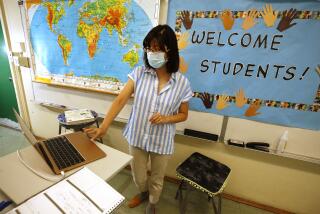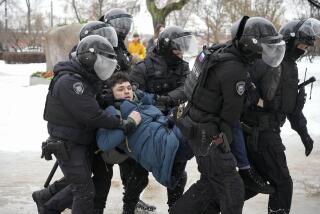COLUMN ONE : Searching for Truth Amid Lies : As once sacred institutions fall and old leaders are discredited, Soviet history teachers struggle to help their students separate fact from fiction.
- Share via
MOSCOW — Branislava S. Fridman has been teaching history to Moscow schoolchildren for 41 years, but these days she has to spend three hours a night preparing her lessons.
That’s because much of what she used to teach now looks more like fiction than history. And Fridman, along with so many other teachers, is searching for the truth. Most nights and every weekend, Fridman sits at her desk at home and digs through newly published Soviet history books, scholarly periodicals and even translations of books on Soviet history published abroad to prepare for class.
“Because we are re-evaluating our history, I need to take a new approach to almost every lesson,” said Fridman, a petite 64-year-old who has taught ninth-, 10th- and 11th-grade history since 1950.
But breaking from the old party ideology is not easy. “No matter how fast they publish textbooks,” Fridman said, “they can’t keep pace with the changes in the way we interpret our history.”
Such interpretations will play an important role in shaping the attitudes of young people in a Soviet Union that is headed for dissolution by year’s end. As institutions topple and old leaders are discredited, students are fast losing any sense of national pride. So, while many instructors relish their new freedom and are happy to destroy myths, they also hope to emphasize their history’s bright moments and brightest lights.
“My students don’t really have any heroes from our past because so many of their childhood heroes have turned out to be false heroes,” said Tamara N. Eidelman, who works at a progressive Moscow school for students especially talented in the humanities. “They’re much more likely to pick Arnold Schwarzenegger as a hero.
“But I think this is OK. I’d much prefer that they think freely rather than unquestioningly love Lenin like generations of schoolchildren before them.”
Criticism of Soviet history has grown dramatically over the last several years. While in the first years of glasnost it was radical to speak evil of dictator Josef Stalin, people now question whether the Soviets were mistaken from the very beginning. Not until after the failure of the hard-line coup in August did Bolshevik leader V. I. Lenin and the 1917 Revolution completely fall from grace.
So, too, with the view of collective farms. As President Mikhail S. Gorbachev’s reforms allowed increasing openness in the classrooms, teachers started to criticize the brutality of mass collectivization under Stalin, when millions of people were killed. Now teachers go further, challenging their students to decide for themselves whether the concept of collective farms was flawed from the outset.
And as heroes become villains, some old villains gain respectability. In the official Soviet version of history, Pyotr A. Stolypin, a pre-revolutionary prime minister, was a bloody executioner who tried to suppress socialism. Now, with private ownership in vogue, instructors teach the positive aspects of Stolypin’s land reforms, which set up private peasant-owned farms across the European parts of Russia from 1906 to 1916.
With dozens of new political parties making the news, pupils are eager to learn the history of parties from their country’s past. The Constitutional Democratic Party, or Kadets, from the early 1900s is one of the students’ favorites, teachers say. The party, which advocated a constitutional monarchy like Britain’s, was one of the most influential political forces after the 1905 revolution but was all but blotted out after the Bolshevik Revolution.
Students also have started demanding details about economic history. Some teachers dedicate whole classes to explaining the historic role of long-denounced commodity and stock exchanges.
For teachers reared to believe that the Kremlin’s version of history was sacred, the new thinking is taking a toll both professionally and emotionally.
A Communist Party member until after the August coup, instructor Fridman has found it easier to give up some ideas than others. “It was easy to become a critic of Stalin after I learned about how many millions of people he slaughtered,” she recalled. “But it was difficult to adjust my thinking about Lenin and the principles of the Bolshevik Revolution.” Adapting, she says, has been a “painful, gradual process.”
Alexei M. Vodyansky, a history instructor who now lectures at a teaching institute, said, “We were all used to history being an exact science, and now it’s a pluralistic vacuum.”
Before Gorbachev’s reforms, teachers were unlikely to contradict the official version of history. In many areas, teachers had to be approved by district Communist Party bosses. Once they started teaching, classes could be monitored at any time by the school director, the school’s Communist Party organization or a district inspector. Dismissals were rare, but the mere threat kept teachers in line.
Now, most teachers seem to favor historical accuracy. But making the necessary curriculum changes is complicated by the fact that there are no up-to-date textbooks.
“I have to make up my own curriculum because there are no new ones available,” said Vladimir V. Kuznetsov, 25, who is teaching for the second year at Moscow School No. 32. “I’m lucky because I studied history during the years of perestroika and I had some very good teachers. My years in the institute coincided with the most interesting period for historians in this country. We had access to archives and materials that had always been off-limits before. My background in history is solid, but I’m a lot shakier about the methods of teaching it.”
Textbooks once were written by selected historians and approved by Communist Party headquarters. Although more progressive textbooks were published during perestroika (restructuring), many teachers are still not satisfied with what the central publishing house produces.
Kuznetsov finds the textbooks available for his 10th-grade class so unsuitable that he did not assign them to his advanced class. Instead the 15- and 16-year-olds take notes from his lectures, and he gives them outside reading assignments from newly published history books intended for college students and from scholarly journals.
As for himself, Kuznetsov reads “Questions of History,” a monthly scholarly journal, from cover to cover and heads for the library to read authors as varied as American historian Richard Pipes and revolutionary Leon Trotsky, who was deported by Stalin and later murdered in exile in Mexico.
Teachers outside the cities have the hardest time finding newly released or foreign materials.
In Ekaterinburg, a mid-sized industrial center in Russia’s Ural Mountains, a deputy principal at one school was frustrated that the only materials available for her youngest students extolled Communist principles and Lenin. So she had 100 copies of a pre-revolutionary text reprinted for them to use. The book--published in 1914 to teach the children of commoners in czarist Russia how to write, count and read church texts--was found in an attic by a friend.
“No one here cares about education right now,” said Irina V. Ratimova, the deputy principal.
While some teachers view their new responsibilities as a burden, others such as Tamara Eidelman in Moscow are elated.
In one recent 11th-grade class, Eidelman supervised a spirited debate over whether the Bolsheviks were correct to negotiate the separate peace treaty with Germany that ended World War I for Russia.
Only two of the 20 pupils in the class said they supported Lenin, who was ready to accept Germany’s harsh peace terms to save his new revolution. The rest of the students allied with either Trotsky or Nikolai Bukharin, two of Lenin’s greatest rivals, who were both against signing what is known as the Treaty of Brest-Litovsk.
Sasha Livergant, 16, one of the student Trotskyites, said that lively discourse is routine in Eidelman’s class. “She likes it when we have that kind of discussion and all fight to defend our own opinions,” Livergant said. “This free form of teaching is much more interesting than if she sat and gave us lectures.
“It seems fun for her too, because she really considers our opinions. Even if we disagree with her, she never tells us that her view is right and ours is wrong.”
This day’s lesson was based on an article the students had read in a radical new history book called “Nashe Otchestvo,” which characterizes Lenin as a German agent who gladly padded his pockets with money the Germans gave him in exchange for the cease-fire. Such a debate would have been unimaginable during most of the last 74 years, when Lenin was viewed as almost a god and Trotsky and Bukharin were regarded as traitors.
One of the greatest challenges now is instilling respect for country and civic pride at a time when the Soviet Union and its ideological foundation is fast disintegrating.
“What we used to be proud of no longer exists,” Kuznetsov said. “ . . .I try to regenerate a feeling of pride in them, but it is very difficult. I don’t think that this generation will ever feel this--they have seen too much.”
Cynicism certainly seems prevalent in his 10th-grade class. “There are no heroes to believe in,” said Tamer Amara, 15. “We can’t believe in the old Communist heroes, and no one remembers the old Russian heroes because during the Soviet period we talked only about the Communist leaders.”
More to Read
Sign up for Essential California
The most important California stories and recommendations in your inbox every morning.
You may occasionally receive promotional content from the Los Angeles Times.










